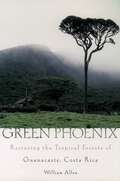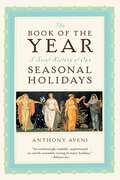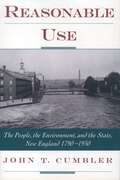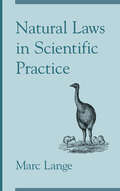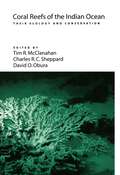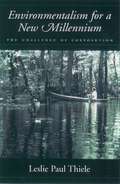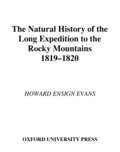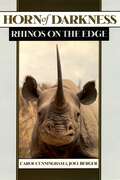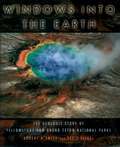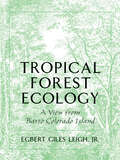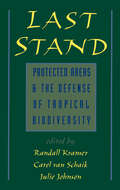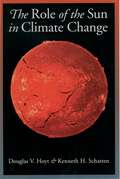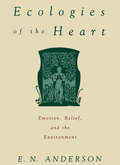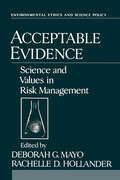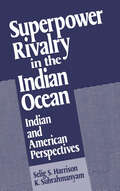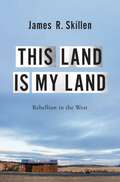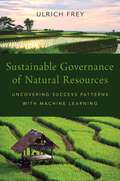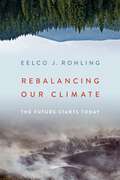- Table View
- List View
Green Phoenix: Restoring the Tropical Forests of Guanacaste, Costa Rica
by William AllenCan we prevent the destruction of the world's tropical forests? In the fire-scarred hills of Costa Rica, award-winning science writer William Allen found a remarkable answer: we can not only prevent their destruction--we can bring them back to their former glory. In Green Phoenix, Allen tells the gripping story of a large group of Costa Rican and American scientists and volunteers who set out to save the tropical forests in the northwestern section of the country. It was an area badly damaged by the fires of ranchers and small farmers; in many places a few strands of forest strung across a charred landscape. Despite the widely held belief that tropical forests, once lost, are lost forever, the team led by the dynamic Daniel Janzen from the University of Pennsylvania moved relentlessly ahead, taking a broad array of political, ecological, and social steps necessary for restoration. They began with 39 square miles and, by 2000, they had stitched together and revived some 463 square miles of land and another 290 of marine area. Today this region is known as the Guanacaste Conservation Area, a fabulously rich landscape of dry forest, cloud forest, and rain forest that gives life to some 235,000 species of plants and animals. It may be the greatest environmental success of our time, a prime example of how extensive devastation can be halted and reversed. This is an inspiring story, and in recounting it, Allen writes with vivid power. He creates lasting images of pristine beaches and dense forest and captures the heroics and skill of the scientific teams, especially the larger-than-life personality of the maverick ecologist Daniel Janzen. It is a book everyone concerned about the environment will want to own.
The Book of the Year: A Brief History of Our Seasonal Holidays
by Anthony F. AveniWhat is the connection between May Day and the Statue of Liberty? Between ancient solstice fires and Fourth of July fireworks? Between St. Valentine, the Groundhog, and the Virgin Mary? In The Book of the Year, Anthony Aveni offers fascinating answers to these questions and explains the many ways humans throughout time have tried to order and give meaning to time's passing. Aveni traces the origins of modern customs tied to seasonal holidays, exploring what we eat, the games we play, the rituals we perform, and the colorful cast of characters we invent to dramatize holidays. Along the way, Aveni illuminates everything from the Jack 'O Lantern and our faith in the predictive power of animals to the ways in which Labor Day reflects the great medieval "time wars," when the newly invented clock first pitted labor against management. Vividly written, filled with facts both curious and astonishing, this engrossing book allows us to hear that beat more clearly and to understand more fully the rhythms we all dance to throughout the year.
Aldo Leopold and the Ecological Conscience
by Richard L. Knight Susanne RiedelIn Aldo Leopold and an Ecological Conscience ecologists, wildlife biologists, and other professional conservationists explore the ecological legacy of Aldo Leopold and his A Sand County Almanac and his contributions to the environmental movement, the philosophy of science, and natural resource management. Twelve personal essays describe the enormous impact he has had on each author, from influencing the daily operations of the U.S. Fish and Wildlife Service and the creation of a land-use ethics guide for Forest Service personnel, to much needed inspiration for continuing on in today's large, complex and often problematic world of science. Here is Aldo Leopold as a mentor, friend, and companion and an affirmation of his hope that science will continue to be practiced in the cause of conservation.
Reasonable Use: The People, The Environment, And The State, New England 1790-1930
by John T. CumblerThis book is a study of the impact of industrialization and urbanization on the environment of New England in general and the Connecticut River Valley in particular, and of the varied public responses the impact engendered. The narrative engages the reader with biographical vignettes woven into the larger narrative and crosses several historical fields by combining industrial, urban, environmental, legal, and political history.
Coral Reefs Of The Indian Ocean: Their Ecology And Conservation
by T. R. McClanahan C. R. C. Sheppard D. O. OburaCoral Reefs of the Indian Ocean: Their Ecology and Conservation
by T. R. McClanahan C. R. C. Sheppard D. O. OburaCoral reefs are among Earth's most diverse, productive, and beautiful ecosystems, but until recently, their ecology and the means to manage them have been poorly understood and documented. In response to the inadequate information base for coral reefs, this book reviews the ecological and conservation status of coral reefs of the Western Indian Ocean, bringing together presentations of the region's leading scientists and managers working on coral reefs. Coral Reefs of the Indian Ocean: Their Ecology and Conservation starts with a general overview of the biogeography of the region and a historical account of attempts to conserve this ecosystem. It goes on to describe the state of the reefs in each of the countries with coral reefs, and it concludes with a series of management case studies. The book also summarizes most of the existing ecological information on reefs in this region and efforts at management, making it useful for students, teachers, and investigators interested in tropical or marine ecology, conservation biology and management, and environmental sciences.
Environmentalism For A New Millennium: The Challenge Of Coevolution
by Leslie Paul ThieleThe vast majority of people in the industrialized world consider themselves environmentalists. Yet environmental problems continue to worsen. While the environmental movement is winning the battle for the hearts and minds of citizens in the United States and across the globe, it may be losing the war to preserve the health of the planet and its biological diversity. The reasons become clear in this book. Leslie Paul Thiele provides a much needed analysis of the driving forces within the environmental movement and the key challenges that it faces. He begins with a concise history of the movement in the United States, where he identifies four successive waves of environmental thought and action. The first wave, conservation, emerged in the mid 1800s and focused on the responsible use of natural resources and the preservation of isolated tracts of wilderness. By the 1960s, the general public had become aware of the widespread impact of environmental problems on human health and welfare. A concern for the containment of industrial society's environmental degradation emerged. This second wave was followed by a period of co optation beginning in the 1980s, as a now popular social movement made a significant impact on public policy and witnessed the dilution of its goals. Thiele largely focuses on the fourth and current wave of coevolution. Coevolutionary thought and action is grounded in the interdependence of humans and nature in a global context. With the goal of sustainable development in mind, contemporary environmentalists argue that human livelihoods must be integrated into complex and evolving ecological systems. This affirmation of coevolutionary interdependence has brought coherence to an inherently diverse social movement. Through extensive interviews and a critical study of environmental publications and scholarly research, the author provides an inside look at the environmental movement. His analysis illuminates the social, economic, political and cultural forces that shape the environmental movement today and set its trajectory for the 21st century. Anyone interested the future of environmentalism will find this book an invaluable guide.
The Natural History Of The Long Expedition To The Rocky Mountains (1819-1820)
by Howard Ensign EvansHorn of Darkness: Rhinos on the Edge
by Carol Cunningham Joel BergerThe black rhino is nature's tank, feared by all animals. Even lions will break off a hunt to detour around one. And yet the black rhino is on the edge of extinction, its numbers dwindling from 100,000 at the turn of the century, to less than 2,500 today. The reason is that in places like Yemen, China, Korea, Taiwan, and Thailand, the rhino's horn is more valuable than gold, so valuable that people will risk their lives to harvest it. To deter rhino poachers, African governments have spent millions--on helicopters, paramilitary operations, fences and guard dogs, even relocation to protected areas. Finally, Namibia decided to dehorn its rhino population, in a last ditch effort to stop the slaughter. In 1991, Carol Cunningham and Joel Berger, and their eighteen-month-old daughter Sonja, went to Namibia to weigh the effects of dehorning on rhinos. In Horn of Darkness, they tell the story of three years in the Namib Desert, studying Africa's last sizable population of free-roaming black rhinos. This is the closest most readers will come to experiencing life in the remaining wilds of Africa. Cunningham and Berger, writing alternate chapters, capture what it is like to leave the comforts of civilization, to camp for months at a time in a land filled with deadly predators, to study an animal that is reclusive, unpredictable, and highly dangerous. The authors describe staking out water holes in the dead of the night, creeping to within twenty-seven meters of rhinos to photograph them, all the while keeping a lookout for hyenas, elephants, and lions. They recount many heart-pounding escapes--one rhino forces Carol Cunningham up a tree, an unseen lion in hot pursuit of hyenas races right past a frozen Joel Berger--and capture the adrenaline rush of inching closer to a rhino that might flee--or charge--at any moment. They also give readers a clear sense of the careful, patient work involved in studying animals, the frustration of long days without finding rhinos or seeing other people, coping with heat and thirst (the Namib desert is one of the driest on Earth), with dirt and insects, driving hundreds of kilometers in a Land Rover packed to capacity, slowing amassing records on one hundred individual rhinos over the course of several years. And perhaps most important, the authors reveal that the data they collected suggests that the dehorning project might backfire--that in the four years after dehorning began, calf survival was down (the evidence suggests that hyenas might be preying on calves and the hornless mothers couldn't defend their offspring). They also describe the dark side of scientific work, from the petty jealousy of other scientists--outside researchers were often seen as ecological imperialists--to the controversy that erupted after the authors published their findings, as furious officials of the Namibian conservation program denounced their findings and through delays and other tactics effectively withheld a permit to allow the couple to continue their study. Weaving together the historical accounts of other naturalists, a vividly detailed look at life in the wild, and a behind-the-scenes glimpse of scientific work and the dark side of the conservation movement, Horn of Darkness is destined to be a classic work on the natural world.
Windows into the Earth: The Geologic Story of Yellowstone and Grand Teton National Parks
by Robert B. Smith Lee J. SiegelMillions of years ago, the North American continent was dragged over the world's largest continental hotspot, a huge column of hot and molten rock rising from the Earth's interior that traced a 50-mile wide, 500-mile-long path northeastward across Idaho. Generating cataclysmic volcanic eruptions and large earthquakes, the hotspot helped lift the Yellowstone Plateau to more than 7,000 feet and pushed the northern Rockies to new heights, forming unusually large glaciers to carve the landscape. It also created the jewel of the U.S. national park system: Yellowstone. Meanwhile, forces stretching apart the western U.S. created the mountainous glory of Grand Teton National Park. These two parks, with their majestic mountains, dazzling geysers, and picturesque hot springs, are windows into the Earth's interior, revealing the violent power of the dynamic processes within. Smith and Siegel offer expert guidance through this awe-inspiring terrain, bringing to life the grandeur of these geologic phenomena as they reveal the forces that have shaped--and continue to shape--the greater Yellowstone-Teton region. Over seventy illustrations--including fifty-two in full color--illuminate the breathtaking beauty of the landscape, while two final chapters provide driving tours of the parks to help visitors enjoy and understand the regions wonders. Fascinating and informative, this book affords us a striking new perspective on Earth's creative forces.
Tropical Forest Ecology: A View from Barro Colorado Island
by Egbert Giles LeighIn Tropical Forest Ecology, Egbert G. Leigh, Jr., one of the world's foremost tropical ecologists, introduces readers to the tropical forest and describes the intricate web of interdependence among the great diversity of tropical plants and animals. Focusing on the tropical forest of Barro Colorado Island, Panama, Leigh shows what Barro Colorado can tell us about other tropical forests--and what tropical forests can tell us about Barro Colorado. This book considers three essential questions for understanding the ecological organization of tropical forests. How do they stay green with their abundance of herbivores? Why do they have such a diversity of plants and animals? And what role does mutualism play in the ecology of tropical forests? Beautifully written and abundantly illustrated, Tropical Forest Ecology will certainly appeal to a wide variety of scientists in the fields of evolution, tropical biology, botany, zoology, and natural history.
Last Stand: Protected Areas And The Defense Of Tropical Biodiversity
by Randall Kramer Carel Van Schaik Julie JohnsonThe Role Of The Sun In Climate Change
by Douglas V. Hoyt Kenneth H. SchattenThe luminosity of the sun governs the temperatures of the planets. Yet the solar forcing, or driving, of climate, primarily due to changes in solar radiation, has never been well documented. Recent satellite measurements have shown that solar radiation varies as a function of time andwavelength, a concept that has been hypothesized for the past two centuries and has recently become a major topic with all the attention paid to global warming. This book reviews the physics of the concept of solar forcing, from its beginnings in the early 1800's and apparent success in the 1870's, to its near demise in the 1950's and recent resurgence. Since its emphasis is on solar variations as a driver for climate change, with only a brief discussion of other mechanisms, the book will be of most interest to students in climate studies.
Ecologies Of The Heart: Emotion, Belief, And The Environment
by E. N. AndersonThere is much we can learn about conservation from native peoples, says Gene Anderson. While the advanced nations of the West have failed to control overfishing, deforestation, soil erosion, pollution, and a host of other environmental problems, many traditional peoples manage their natural resources quite successfully. And if some traditional peoples mismanage the environment--the irrational value some place on rhino horn, for instance, has left this species endangered--the fact remains that most have found ways to introduce sound ecological management into their daily lives. Why have they succeeded while we have failed? In Ecologies of the Heart , Gene Anderson reveals how religion and other folk beliefs help pre-industrial peoples control and protect their resources. Equally important, he offers much insight into why our own environmental policies have failed and what we can do to better manage our resources. A cultural ecologist, Gene Anderson has spent his life exploring the ways in which different groups of people manage the environment, and he has lived for years in fishing communities in Hong Kong, Malaysia, Singapore, Tahiti, and British Columbia--as well as in a Mayan farmtown in south Mexico--where he has studied fisheries, farming, and forest management. He has concluded that all traditional societies that have managed resources well over time have done so in part through religion--by the use of emotionally powerful cultural symbols that reinforce particular resource management strategies. Moreover, he argues that these religious beliefs, while seeming unscientific, if not irrational, at first glance, are actually based on long observation of nature. To illustrate this insight, he includes many fascinating portraits of native life. He offers, for instance, an intriguing discussion of the Chinese belief system known as Feng-Shui (wind and water) and tells of meeting villagers in remote areas of Hong Kong's New Territories who assert that dragons live in the mountains, and that to disturb them by cutting too sharply into the rock surface would cause floods and landslides (which in fact it does). He describes the Tlingit Indians of the Pacific Northwest, who, before they strip bark from the great cedar trees, make elaborate apologies to spirits they believe live inside the trees, assuring the spirits that they take only what is necessary. And we read of the Maya of southern Mexico, who speak of the lords of the Forest and the Animals, who punish those who take more from the land or the rivers than they need. These beliefs work in part because they are based on long observation of nature, but also, and equally important, because they are incorporated into a larger cosmology, so that people have a strong emotional investment in them. And conversely, Anderson argues that our environmental programs often fail because we have not found a way to engage our emotions in conservation practices. Folk beliefs are often dismissed as irrational superstitions. Yet as Anderson shows, these beliefs do more to protect the environment than modern science does in the West. Full of insights, Ecologies of the Heart mixes anthropology with ecology and psychology, traditional myth and folklore with informed discussions of conservation efforts in industrial society, to reveal a strikingly new approach to our current environmental crises.
Ecologies of the Heart: Emotion, Belief, and the Environment
by E. N. AndersonThere is much we can learn about conservation from native peoples, says Gene Anderson. While the advanced nations of the West have failed to control overfishing, deforestation, soil erosion, pollution, and a host of other environmental problems, many traditional peoples manage their natural resources quite successfully. And if some traditional peoples mismanage the environment--the irrational value some place on rhino horn, for instance, has left this species endangered--the fact remains that most have found ways to introduce sound ecological management into their daily lives. Why have they succeeded while we have failed? In Ecologies of the Heart, Gene Anderson reveals how religion and other folk beliefs help pre-industrial peoples control and protect their resources. Equally important, he offers much insight into why our own environmental policies have failed and what we can do to better manage our resources. A cultural ecologist, Gene Anderson has spent his life exploring the ways in which different groups of people manage the environment, and he has lived for years in fishing communities in Hong Kong, Malaysia, Singapore, Tahiti, and British Columbia--as well as in a Mayan farmtown in south Mexico--where he has studied fisheries, farming, and forest management. He has concluded that all traditional societies that have managed resources well over time have done so in part through religion--by the use of emotionally powerful cultural symbols that reinforce particular resource management strategies. Moreover, he argues that these religious beliefs, while seeming unscientific, if not irrational, at first glance, are actually based on long observation of nature. To illustrate this insight, he includes many fascinating portraits of native life. He offers, for instance, an intriguing discussion of the Chinese belief system known as Feng-Shui (wind and water) and tells of meeting villagers in remote areas of Hong Kong's New Territories who assert that dragons live in the mountains, and that to disturb them by cutting too sharply into the rock surface would cause floods and landslides (which in fact it does). He describes the Tlingit Indians of the Pacific Northwest, who, before they strip bark from the great cedar trees, make elaborate apologies to spirits they believe live inside the trees, assuring the spirits that they take only what is necessary. And we read of the Maya of southern Mexico, who speak of the lords of the Forest and the Animals, who punish those who take more from the land or the rivers than they need. These beliefs work in part because they are based on long observation of nature, but also, and equally important, because they are incorporated into a larger cosmology, so that people have a strong emotional investment in them. And conversely, Anderson argues that our environmental programs often fail because we have not found a way to engage our emotions in conservation practices. Folk beliefs are often dismissed as irrational superstitions. Yet as Anderson shows, these beliefs do more to protect the environment than modern science does in the West. Full of insights, Ecologies of the Heart mixes anthropology with ecology and psychology, traditional myth and folklore with informed discussions of conservation efforts in industrial society, to reveal a strikingly new approach to our current environmental crises.
Atmosphere-Ocean Interaction (Oxford Monographs on Geology and Geophysics)
by Eric B. Kraus Joost A. BusingerWith both the growing importance of integrating studies of air-sea interaction and the interest in the general problem of global warming, the appearance of the second edition of this popular text is especially welcome. Thoroughly updated and revised, the authors have retained the accessible, comprehensive expository style that distinguished the earlier edition. Topics include the state of matter near the interface, radiation, surface wind waves, turbulent transfer near the interface, the planetary boundary layer, atmospherically-forced perturbations in the oceans, and large-scale forcing by sea surface buoyancy fluxes. This book will be welcomed by students and professionals in meteorology, physical oceanography, physics and ocean engineering.
Superpower Rivalry In The Indian Ocean: Indian And American Perspectives
by Selig S. Harrison K. SubrahmanyamThis Land is My Land: Rebellion in the West
by James R. SkillenAmong American conservatives, the right to own property free from the meddling hand of the state is one of the most sacred rights of all. But in the American West, the federal government owns and oversees vast patches of land, complicating the narrative of western individualism and private property rights. As a consequence, anti-federal government sentiment has animated conservative politics in the West for decades upon decades. In This Land Is My Land, James R. Skillen tells the story of conservative rebellion-ranging from legal action to armed confrontations-against federal land management in the American West over the last forty years. He traces the successive waves of conservative insurgency against federal land authority-the Sagebrush Rebellion (1979-1982), the War for the West (1991-2000), and the Patriot Rebellion (2009-2016)-and shows how they evolved from regional revolts waged by westerners with material interests in federal lands to a national rebellion against the federal administrative state. Cumulatively, Skillen explains how ranchers, miners, and other traditional users of federal lands became powerful symbols of conservative America and inseparably linked to issues of property rights, gun rights, and religious expression. Not just a book about property rights battles over Western lands, This Land is My Land reveals how the evolving land-based conflicts in the West since the 1980s reshaped the conservative coalition in America-a development that ultimately helped lead to the election of President Donald J. Trump in 2016.
This Land is My Land: Rebellion in the West
by James R. SkillenAmong American conservatives, the right to own property free from the meddling hand of the state is one of the most sacred rights of all. But in the American West, the federal government owns and oversees vast patches of land, complicating the narrative of western individualism and private property rights. As a consequence, anti-federal government sentiment has animated conservative politics in the West for decades upon decades. In This Land Is My Land, James R. Skillen tells the story of conservative rebellion-ranging from legal action to armed confrontations-against federal land management in the American West over the last forty years. He traces the successive waves of conservative insurgency against federal land authority-the Sagebrush Rebellion (1979-1982), the War for the West (1991-2000), and the Patriot Rebellion (2009-2016)-and shows how they evolved from regional revolts waged by westerners with material interests in federal lands to a national rebellion against the federal administrative state. Cumulatively, Skillen explains how ranchers, miners, and other traditional users of federal lands became powerful symbols of conservative America and inseparably linked to issues of property rights, gun rights, and religious expression. Not just a book about property rights battles over Western lands, This Land is My Land reveals how the evolving land-based conflicts in the West since the 1980s reshaped the conservative coalition in America-a development that ultimately helped lead to the election of President Donald J. Trump in 2016.
Sustainable Governance of Natural Resources: Uncovering Success Patterns with Machine Learning
by Ulrich FreyWhat can be done to ensure natural resources aren't exploited? Is it possible to determine how to sustainably manage them? What makes some systems successful? In Sustainable Governance of Natural Resources, Ulrich Frey delves deep into unanswered questions like these about resource management. The book explains the current state of biological cooperation mechanisms, case studies in the field, findings from economic-behavioral experiments, common-pool resource dilemmas, and how these are all relevant to these questions surrounding the best way to sustainably manage natural resources. There are many case studies within the field of social-ecological systems, but there are few large-N studies conducted in a methodologically rigorous manner. Frey does just this and takes readers step-by-step through the preparation of datasets like the CPR, NIIS, and IFRI. He also grounds his research through the development of an indicator system which operationalizes 24 individually-synthesized success factors that influence the management of natural resources. The book reveals the practical and operational uses of measuring ecological success in this way, showcasing various statistical and machine learning methods to develop highly predictive, robust, and empirically-sound models. Three different methods, multivariate linear regressions, random forests, and artificial neural networks are compared to achieve robust results. The book sheds new light on factors that have previously been investigated, allowing readers to build off of Frey's system and use his methods to determine whether or not their way of managing natural resources will yield ecological success in practice.
Sustainable Governance of Natural Resources: Uncovering Success Patterns with Machine Learning
by Ulrich FreyWhat can be done to ensure natural resources aren't exploited? Is it possible to determine how to sustainably manage them? What makes some systems successful? In Sustainable Governance of Natural Resources, Ulrich Frey delves deep into unanswered questions like these about resource management. The book explains the current state of biological cooperation mechanisms, case studies in the field, findings from economic-behavioral experiments, common-pool resource dilemmas, and how these are all relevant to these questions surrounding the best way to sustainably manage natural resources. There are many case studies within the field of social-ecological systems, but there are few large-N studies conducted in a methodologically rigorous manner. Frey does just this and takes readers step-by-step through the preparation of datasets like the CPR, NIIS, and IFRI. He also grounds his research through the development of an indicator system which operationalizes 24 individually-synthesized success factors that influence the management of natural resources. The book reveals the practical and operational uses of measuring ecological success in this way, showcasing various statistical and machine learning methods to develop highly predictive, robust, and empirically-sound models. Three different methods, multivariate linear regressions, random forests, and artificial neural networks are compared to achieve robust results. The book sheds new light on factors that have previously been investigated, allowing readers to build off of Frey's system and use his methods to determine whether or not their way of managing natural resources will yield ecological success in practice.
Rebalancing Our Climate: The Future Starts Today
by Eelco J. RohlingWe only have one planet, and its climate and ecosystem are essential to our survival. A veritable tsunami of studies and assessment reports outlines a stark picture of humanity's detrimental impacts on our planet's life and environmental health. Climate change is at the heart of many of these impacts. We cannot continue to live in the same way; we're facing relentless population growth, paired with ever-expanding energy and resource consumption. Every day we dither exacerbates the issues we have to repair. What are our options, though? We can still avert the doomsday scenario and choose more sustainable behavior. Decisive action can still make a significant difference to our environment. In Rebalancing Our Climate, Eelco J. Rohling documents a wealth of ways to adjust the trajectory of climate change. He outlines measures to drive massive reductions of greenhouse gas emissions, remove these gases from our atmosphere, and reflect part of the incoming energy from the Sun back into space. The book evaluates both advantages and disadvantages of changing our behaviour. Rohling thus addresses the issues that affect the pathways to our survival in an understandable way. He also showcases the need to protect ourselves from impacts that have become inevitable already and presents ways to drive society to get these jobs done. The resulting book provides powerful facts and arguments to support informed choices about how we manage our dear planet.
